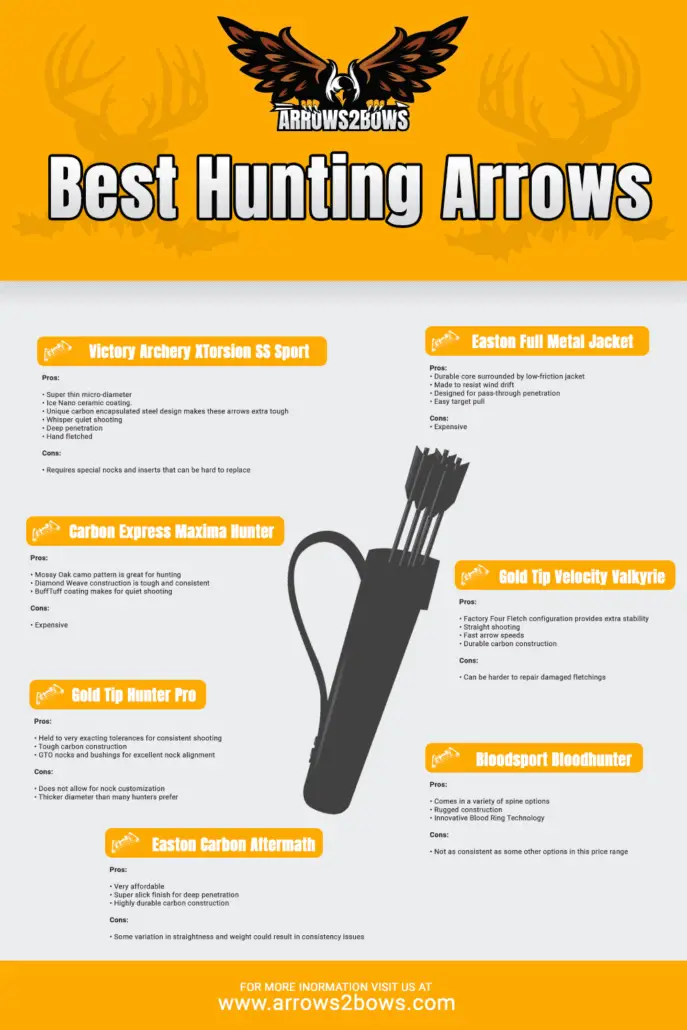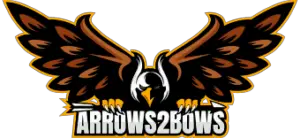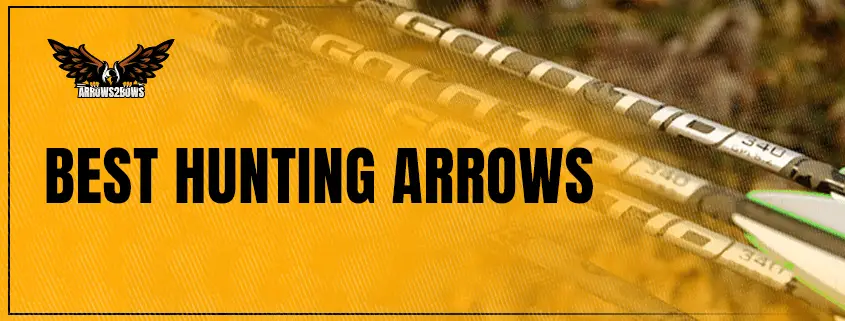Best Hunting Arrows
Having a high-quality compound bow is essential for hunting success. However, even the most expensive rig won’t do you any good if you don’t have the best hunting arrows to go with it. Believe it or not, the arrows you shoot may be the most important factor in successfully filling your tags.
With so much on the line, you should carefully consider which arrows you put in your quiver each fall. The right arrows will not only increase consistency and accuracy, they will also increase penetration. These characteristics will help your shots deliver quick, humane kills and game that is easier to recover.
If you aren’t sure what to look for in a hunting arrow, we are here to help. In this article, we will delve into what makes a good hunting arrow. As a bonus, we’ll finish it off with some of our own favorite hunting arrows.
In a Hurry? Check This Out:
Victory Archery XTorsion SS Sport
These micro-diameter arrows deliver blistering speeds that cut through crosswinds like a hot knife through butter. With less surface area than standard diameter arrows, these arrows produce less friction, allowing them to slip into vitals and come out the other side without breaking a sweat.
They are hand-fletched and feature a super tough, carbon-encapsulated stainless steel construction. They are also whisper-quiet. What more could you ask for in a hunting arrow?
How to Choose the Best Hunting Arrows
Most archers learn the ins and outs of compound bows pretty quickly. However, even seasoned bowhunters may be completely dumbfounded when it comes to arrow selection. There also isn’t a whole lot of clear information available, and hunters tend to have their own differing opinions about what you should be shooting.
Try not to get too bogged down with brands. Every major arrow manufacturer produces some terrific arrows. Rather than brand name, consider the game you plan to hunt and the needs of your hunting set-up.
There are several factors to consider when selecting your hunting arrows. Let’s take a look at the basics.
Arrow Diameter
Modern arrows come in a wide array of diameters. Generally speaking, bowhunters should look for arrows on the smaller, thinner end of the scale.
The thicker the arrow, the more surface area it has, and the quicker it slows down in flight. A thinner arrow will maintain more speed over distance. It will also deliver more kinetic energy and better penetration, especially at longer distances.
Thinner arrows are also less affected by wind, making them a better option for outdoor shooting.
However, choosing a micro-shaft arrow will require special components. Standard nocks and inserts aren’t going to work. For simplicity, some bowhunters choose to stick with standard arrow shaft diameters.
Spine
Although your arrow may seem pretty straight when nocked on your bowstring, it actually wiggles when it takes off through the air. Referred to as the “Archer’s Paradox,” this phenomenon is caused by the forward thrust of the bowstring, which causes the shaft to bend in one direction. The arrow then reacts in the opposite direction, causing the arrow to wiggle its way downrange like a snake until it straightens out further down range.
Don’t believe me? Check out this slow motion video.
Spine is the measurement of an arrow’s flexibility. Stiff arrows may not “wiggle” enough in the air. This can cause the arrow to fly sideways because there isn’t enough flexibility for it to react by “wiggling” in the opposite direction after release. However, arrows that are too flexible may never completely straighten, and will flop downrange like a wet spaghetti noodle. The trick is to find that Goldilocks sweet spot for your bow set-up.
Arrow spine is usually represented by a 3-digit number printed somewhere on the arrow shaft. Also referred to as a deflection, spine ratings are determined by taking an arrow shaft that is 28 inches long and hanging a 1.94-pound weight at its center. The amount the arrow flexes due to the weight is measured and determines the arrow’s “static” spine rating.
Most commonly, you will see numbers like 500, 400, 340, or 300 (Although there are others). Usually, an arrow with a 300 spine rating deflects .300 inches from the horizontal center when the weight is attached. The lower the number, the stiffer the arrow shaft.
Unfortunately, not all arrow manufacturers use the same spine numbers. Be sure to check the company’s specific information to make sure you are comparing apples to apples.
Choosing Arrows with the Right Spine
There are a few important factors that help determine the spine of the arrows you should be shooting – draw weight, arrow length, and point weight.
Draw Weight
The more weight that drives behind an arrow, the more it will flex. If you are shooting a bow with a heavy draw weight, you should generally choose arrows with a lower numerical spine rating.
Knowing how much weight you are shooting is the first step in determining your spine requirements. A few pounds can make a big difference in what you should be shooting.
The only way to know the exact draw weight of your bow is to use a bow scale. Even if the bow’s manufacturer claims their draw weight is 60 pounds, the actual draw weight may measure in at only 57. Although relatively small, that three-pound difference could influence how much flex is created in the arrow upon release.
Arrow Length
Arrows are measured from the deepest point of the nock to the end of the shaft (excluding points or broadheads). Longer arrows naturally flex more than short arrows. Remember the spine is measured with a 28-inch shaft. If you use arrows that are longer than 28 inches, they will be slightly more flexible. Conversely, arrows shorter than 28 inches will be stiffer.
Point Weight
The weight of your broadheads also affects how much your arrows flex. Heavier points cause an arrow to flex more than lighter points. For example, heavy 125-grain broadheads will result in more flex than the same arrows tipped with 85-grain broadheads. If you plan to shoot heavy broadheads (and you probably should), you will want to choose arrows with a lower numerical spine rating (i.e. stiffer arrows) to go with them.
If you do any shooting with field points during the off-season, make sure to use tips with the same grain weight as your hunting broadheads. This will help make sure you stay properly spined.
Arrow Weight
Although it is easy to confuse arrow spine and arrow weight, they are two very different things. Remember, arrow spine refers to how flexible the shaft is. Arrow weight refers to how much the arrow weighs. (How is that for obvious?)
The best arrow weight for hunting is a hotly debated topic. An almost infinite number of variables affect arrow performance in any given hunting scenario. It is practically impossible to pick one “perfect” arrow weight.
As a basic rule of thumb, an arrow that weighs 400 grains or more is enough to bring down most North American big game animals. However, a heavier arrow may offer better performance for larger Western game. Ultimately, bowhunters should find a weight they feel comfortable shooting and then practice, practice, practice.
Arrow Length
The proper arrow length mostly depends on your draw length. Choose arrows that are 1-2 inches longer than your draw length. You may need to have stock arrows cut to the proper length.
Straightness Tolerance
It makes sense that straight arrows will fly more accurately than arrows that are bent or curved. However, sometimes arrow straightness is difficult to discern with the naked eye. Thankfully, most manufacturers provide a “straightness tolerance”.
Arrows generally fall into one of three straightness categories: .006”, .003”, and .001”. An arrow with a .001” tolerance will not deviate beyond 1/1000 an inch from its true center.
Straightness tolerance is determined using the standard 28-inch shaft. Longer arrows may not have the same consistent straightness as shorter arrows.
The straighter your arrows, the more consistently they will fly, and the better accuracy they will deliver, especially at ranges over 40 yards. However, expect to invest more for arrows with better straightness tolerance.
Arrow Materials
Although wood is the traditional arrow material, modern arrows are typically made from aluminum, carbon, or a composite blend of the two.
Aluminum Arrows
When it comes to hunting arrow material, aluminum is by far the most affordable. Aluminum arrows come in a variety of spine ratings. However, an aluminum arrow will weigh more than a carbon arrow with the same spine.
Many bowhunters choose aluminum arrows, because they are deadly quiet to shoot.
The major drawbacks of hunting with aluminum arrows is that they bend easily, and they aren’t as “flat-shooting” as arrows made from other materials.
Carbon Arrows
Carbon arrows are the most popular arrow choice for bowhunters. Most hunters choose carbon because it is lighter and more durable than aluminum. Carbon arrows also produce faster velocities and deliver deeper penetration. Carbon arrows are a bit pricier than most aluminum options, so be prepared to invest a little more for the increase in performance.
Composite Arrows
Composite arrows are generally made from a hybrid of aluminum and carbon (although sometimes other metals are included in construction). By using a composite material, manufacturers can combine the benefits of both materials.
Composite arrows are the straightest, most uniformly spined arrows available to the modern hunter. They also deliver superior long-distance accuracy. However, this is the most expensive option. If you lose a lot of arrows, you might want to consider something more economically priced.
Fletchings
Another aspect to consider when choosing your hunting arrows is whether you want them pre-fletched or raw. The benefit of purchasing pre-fletched arrows is they come ready to hunt right out of the package. However, by using pre-fletched arrows, you lose all control of consistency. You’ll just have to hope the manufacturer takes consistency as seriously as you do.
Our Top Picks
Victory Archery XTorsion SS Sport
Victory Archery takes micro-diameter arrows to the next level with the XTorsion SS Sport. Measuring only .204 inches in diameter, these super slender arrows produce blistering speeds and reduce wind deflection.
Delivering unparalleled impact force, XTorsion SS Sport arrows are engineered with layers of 304 stainless steel encapsulated within high modulus carbon fiber. The result of this unique design is a seriously strong arrow that cuts through wind and thick hide to deliver unbelievable penetration.
We also love the Ice Nano ceramic coating, which is designed to reduce friction, increase penetration, and allow smooth, easy removal from foam targets.
XTorsion arrows are built with a +/- .006-inch straightness. Each arrow includes a 30-grain aluminum Shok insert and a Bohning A-nock. These arrows are also hand-fletched with Blazer Vanes.
Pros:
- Super thin micro-diameter
- Ice Nano ceramic coating.
- Unique carbon encapsulated steel design makes these arrows extra tough
- Whisper quiet shooting
- Deep penetration
- Hand fletched
Cons:
- Requires special nocks and inserts that can be hard to replace
Easton Full Metal Jacket
As the name implies, Easton Full Metal Jacket arrows are designed for pass-through penetration. These slender arrows are constructed with a tough carbon core surrounded by a durable metal jacket made from low-friction aerospace 7075 aluminum. For target practice, the aluminum jacket makes it easier to pull shafts than it is when using full carbon arrows
Perfect for hunting, Easton FMJs fly straight, cut through wind, and punch through thick hide and bone once they reach their target.
Easton FMJ arrows are available as a six or twelve pack. Each arrow measures .269 inches in diameter, has a straightness tolerance of +/- 0.002”, and a 340 spine.
Pros:
- Durable core surrounded by low-friction jacket
- Made to resist wind drift
- Designed for pass-through penetration
- Easy target pull
Cons:
- Expensive
Carbon Express Maxima Hunter
These versatile arrows from Carbon Express are perfect for both hunting and target shooting, making them ideal for bowhunters who also compete in the off-season.
The shaft on the Maxima Hunter is made from an exclusive cross-woven carbon material called Diamond Weave. This proprietary design creates optimal stiffness and impressive spine consistency. The front section of the shaft is covered with Carbon Express’s patented BuffTuff. BuffTuff is one of the toughest and quietest arrow finishes on the market. Plus, the shaft features the popular Mossy Oak Treestand pattern.
Maxima Hunter arrows are laser checked for straightness to +/- 0.0025. Each arrow measures 0.295 inches in diameter.
Pros:
- Mossy Oak camo pattern is great for hunting
- Diamond Weave construction is tough and consistent
- BuffTuff coating makes for quiet shooting
Cons:
- Expensive
Gold Tip Hunter Pro
Gold Tip Hunter Pro arrows are perfect for hunters who like a little more girth to their arrows. These shafts are held to extremely tight tolerances, making them some of the most consistent arrows on the market. They feature a tough carbon construction that holds up well, even when shot through targets, fences, trees, and deer.
The included GTO nocks and bushings provide nearly perfect nock alignment. However, if you prefer to customize your arrows with a light-up nock or other upgrade, you won’t be removing the attached nocks. This might be a deal-breaker for some bowhunters.
Gold Tip Hunter Pro arrows come in 340 grains (measuring .300 inches) and 400 grains (measuring .302 inches) versions. Straightness tolerance is +/- .001 inches.
Pros:
- Held to very exacting tolerances for consistent shooting
- Tough carbon construction
- GTO nocks and bushings for excellent nock alignment
Cons:
- Does not allow for nock customization
- Thicker diameter than many hunters prefer
Easton Carbon Aftermath
These low-profile arrows from industry leader Easton, have a super slick finish that produces less friction and deeper penetration than much of the competition. Don’t be fooled by their small size, these carbon arrows are highly durable and stand up to repeated shooting, whether you are shooting at foam targets or whitetail deer.
These highly affordable American-made arrows measure 0.281 inch in diameter. They have a straightness tolerance of .005 inches.
Pros:
- Very affordable
- Super slick finish for deep penetration
- Highly durable carbon construction
Cons:
- Some variation in straightness and weight could result in consistency issues
Bloodsport Bloodhunter
With four spine options ranging from 500 to 300 you are bound to find the perfect arrows in the Bloodsport Bloodhunter line. These arrows offer +/- .004-inch straightness tolerances, a .244-inch standard diameter, and a tough proprietary carbon Rugged Wrap Construction.
The most exciting thing about these hunting arrows is the unique Blood Ring Technology that allows you to instantly see if your recovered arrow hit vital organs. This innovative white ring lets you see exactly what type and color of blood your arrow passed through, helping you make intelligent trailing decisions.
Pros:
- Comes in a variety of spine options
- Rugged construction
- Innovative Blood Ring Technology
Cons:
- Not as consistent as some other options in this price range
Gold Tip Velocity Valkyrie
Gold Tip’s Velocity Valkyrie arrows are Factory Four Fletched with four low-profile vanes. This design adds some extra surface area that increases back-end stability without sacrificing clearance or speed.
Producing screaming arrow speeds, Velocity Valkyrie arrows measure .246 inches in diameter and come in weights ranging from 600 to 300 grains. Each arrow is held to a straightness tolerance of +/- 0.006 inches.
Pros:
- Factory Four Fletch configuration provides extra stability
- Straight shooting
- Fast arrow speeds
- Durable carbon construction
Cons:
- Can be harder to repair damaged fletchings
Summing It Up
Victory Archery XTorsion SS Sport is our top pick for the best hunting arrow. The thinnest arrows on our list, these micro-diameter arrows fly fast, resist wind deflection, and drive deeper than all the competition. They also have a unique carbon-encapsulated steel construction that offers just the right amount of flex without sacrificing durability. We honestly can’t find a single thing about these arrows to complain about.
We do understand that some bowhunters prefer stouter arrows, especially if they use those same arrows to compete in the off-season. If that describes you, you might prefer Easton’s Full Metal Jacket or Carbon Aftermath.
Carbon Express Maxima Hunter arrows are also great options for bowhunters who want to compete in target archery using their hunting rig to keep skills sharp leading up to hunting season.
However, if hunting is your true passion and main objective, we can’t say enough good things about Victory Archery XTorsion SS Sport arrows.




